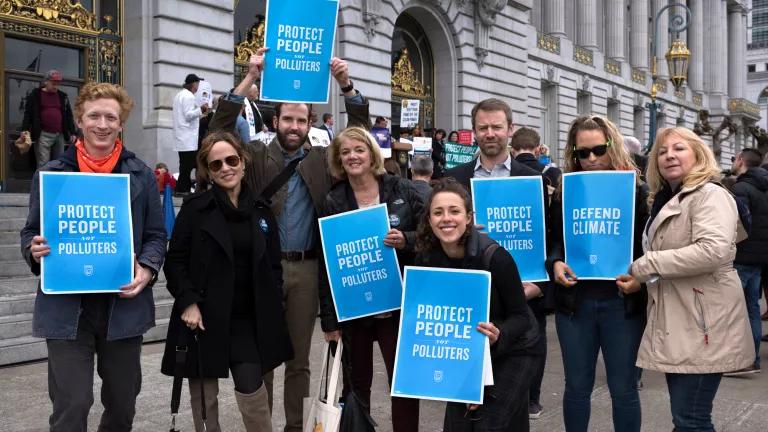Longtime opponents to California’s clean energy laws are at it again, this time under a new banner group called Californians for Affordable and Reliable Energy (“CARE”) that is linked to the lobbyists for the two major opponents to the AB 32 Global Warming Solutions Act (AB32)
As the California Green Business Alliance blogged about yesterday, CARE’s membership consists of the Western States Petroleum Association and the California Manufacturers and Technology Association, both of which are historical opponents of AB 32 and have spent millions over the years trying to kill California’s 2006 law to reduce carbon pollution.
Yesterday, CARE released a report by Navigant Consulting laying the groundwork for their revamped campaign to weaken California’s clean energy laws. Policymakers, businesses, communities, and workers who truly care about growing California’s renewable power, energy efficiency, and alternative fuels should not let a group that claims to “CARE” scare us from the facts:
California households pay much lower electric bills than the national average and neighboring states
The CARE study claims that California energy costs are higher than neighboring states. The fact is that California households pay much lower electric bills than the national average and our bordering states. That’s what consumers really care about – the amount that comes out of their pockets to pay their utility bills every month, not kilowatt hour rates. These lower bills are thanks in part to California’s long and successful history of promoting energy efficiency, our cheapest and cleanest energy resource. This sustained commitment has put California at the head of the class in getting the most bang for every buck spent on electricity, and keeping more dollars in the pockets[1] of households and businesses.
California’s energy efficiency efforts over the past several decades have helped:
- Save residents and businesses more than $65 billion;
- Make household electric bills 25 percent lower than the national average;
- Create a more productive economy, generating twice as much economic output for every kilowatt hour consumed compared to the rest of the country;
- Decrease utility bills for millions of low-income households; and
- Cut as much climate-warming carbon pollution as is spewed from 5 million cars annually.
California households and businesses can also take advantage of lots of incentives and assistance to lower their bills further. For examples, utilities invest nearly $1 billion each year to help customers improve energy efficiency, with roughly $400 million helping commercial and industrial customers. Each dollar invested typically saves those customers $2 or more.
Yet the benefits of energy efficiency are left on the sidelines in the CARE-Navigant study. As it acknowledges in a footnote, the study does not account for energy efficiency’s role in driving lower electricity consumption and energy bills. Omitting the “principal driver” of California’s energy cost savings leaves out the central character in California’s energy story.
In reality, AB 32 will help continue California’s leadership on saving customers money through energy efficiency. By putting a price on carbon and investing in expanded efficiency programs and technologies, AB 32 will unlock even more efficiency opportunities and encourage customers to find additional cost-effective ways of reducing their energy bills.
Renewable power is affordable and beneficial
The CARE study suggests that renewables will be to blame for future electricity price increases, but fails to consider other factors that are likely to have a bigger impact –such as maintenance and expansion of the state’s electricity grid -- and neglects to mention the economic and environmental benefits that renewables provide.
A 2009 study of California’s 33 percent renewable energy standard estimated that requiring utilities to provide one-third of their energy mix from clean energy sources like wind and solar would increase electricity rates by a total of only 7 percent from 2010 to 2020. The cost of solar power, in particular, has declined rapidly over the past few years, suggesting that even this modest estimate is high . The CARE report also fails to note that costs associated with conventional resources can be very significant, such as the need to replace the unexpected loss of the San Onofre Nuclear Generating System (SONGS) nuclear plant.
The truth is that renewable energy is affordable and helps stabilize electricity prices. Natural gas prices are low now but, as we’ve seen in the past, they might increase substantially in the future. Renewables also help clean the air and create jobs by fueling California’s fast-growing clean energy economy.
Expanding our supplies of Low Carbon Fuels can help reduce pain at the pump
The CARE-Navigant study conducts no new analysis on the state’s Low Carbon Fuel Standard (LCFS), but rehashes the same exorbitant cost claims from previously debunked oil-industry funded studies (see here, here).
What the oil industry-funded studies don’t tell you is that California’s oil saving measures under AB32, including the Low Carbon Fuel Standard, will save California consumers and businesses $50 billion over the next decade in fuel costs. That’s roughly $1,000 annually per household due to cleaner and more efficient cars, expanding supplies of clean fuels, and improved land-use and transportation options.
Programs like the LCFS are clearing the way for innovative companies to create good jobs in California by producing advanced renewable fuels, biogas, cleaner electricity, and plug-in electric cars.
Since 2006, families and businesses have endured over 30 gasoline price spikes. While the oil industry lobby is quick to blame environmental regulations, the reality is that jumps in global crude oil prices were responsible 64% of the time. Of the rest, refinery accidents and equipment failures accounted for 20%, planned refinery shut-downs for maintenance 6%, and seasonal and holiday driving demand represented 10% of the time. Programs like the LCFS will phase in more supplies of clean fuels, helping introduce greater fuel competition, while reducing our dependency on a single energy source.
We won’t be S(CARE)d
We need California’s clean energy law and other programs to start phasing in more clean fuel choices, reduce consumption and phase out our oil dependency. Thanks to smart policies like those in AB 32, we’ll be less vulnerable to future price spikes, helping California move forward while cutting utility bills and pollution.
Let’s make sure the oil industry doesn’t turn us around.



